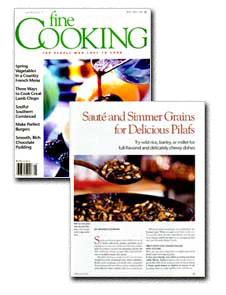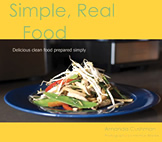|
FLORIDA TREND
April 2003
FOOD & WINE
March 1997
VEGETARIAN TIMES
April 1996
MIAMI HERALD
March 2002
MIAMI HERALD
September 1992
<<BACK TO PRESS PAGE
|
|
Fine Cooking Magazine
May 1997

Sauté and Simmer Grains for Delicious Pilafs
Try wild rice, barley, or millet for full-flavored and
delicately chewy dishes
Sauté your favorite grain with a little onion in oil or butter, add stock, simmer, and then toss in ingredients for texture and flavor, and you've made a pilaf. For starters, you have an appealing, colorful side dish. Add meat, beans, or vegetables, and you'll elevate your pilaf to main-dish status.
The pilaf technique translates well to many grains; though rice is the traditional base, pilaf is adaptable. Barley cooks up plump and sturdy with a pleasantly chewy texture and nutty flavor; coarse-textured millet turns delicate when cooked; it also has a nutty flavor.
Whatever grain you choose, your pilaf will be deliciously easy. When you get home from work, you can quickly chop up some ingredients, put the pan on to simmer, and by the time you've changed clothes and read the mail, dinner's ready.
First Steps Give Grains Flavor and Texture
Here are the extra steps that set pilafs apart from plain boiled or steamed grains.
Dry-toast barley and millet to bring out their nutty flavor. Skillet-toasting also keeps delicate grains like millet from turning mushy during cooking.
Next, sauté onions or shallots in butter or oil. Sautéing these to a deep, golden color adds flavor.
Add the grain. Stir it well to make sure it's coated with oil. A light coating on each grain helps keep the grains from sticking to one another, so you won't end up with a gummy pilaf. And that bit of fat goes a long way to adding flavor.
Fully Cooked Grains are Chewy but Never Crunchy
Grains taste best cooked in vegetable, chicken, or even veal stock. Fish stock or beef broth can be overpowering. I cook grains in plain water only when I want a very simple taste.
The idea is for all the liquid to be absorbed just at the time the grains are done. Keep the pan covered and check for doneness as you approach the end of the recipe's cooking time. If the liquid is all gone but the grain needs more time, add 1/2 cup water, bring it back to a boil, reduce the heat, and continue cooking.
A little bit of bite is fine, but a crunch or a too-chewy texture means the grain is undercooked. If you're happy with the texture of your grain but there's still liquid in the pan, just pour it off.
Grains Welcome more Color, Texture, and Flavor
Most grains are beige or brownish and need a lift of color. Chopped herbs, dried fruits, and diced vegetables break the monotony and add texture and flavor, too. White rice and bulgur tend to turn out fluffy rather than chewy; diced vegetables and nuts are especially good for adding crunch to those grains I don't like tossing in extra oil or butter after cooking. This makes the pilaf too heavy because the grains will just keep absorbing oil, just like pasta does.
Recipes:
Wild Rice Pilaf with Dried Apricots & Pine Nuts
Barley & Wild Mushroom Pilaf
Saffron-Scented Millet Pilaf with Roasted Peppers
<<Back
|
|
 |
Simple, Real Food:
Delicious clean food prepared simply
My cookbook Simple Real Food can be purchased online.
The price is $24.95 and the book can be sent to your home or office. It can be included with a gift certificate for a cooking class as the perfect present.
Book Details
|

|
|
|